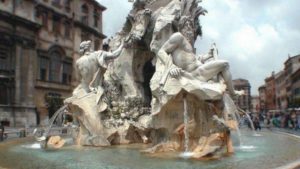Roma pittrice: the city’s women painters, rediscovered
- October 28, 2024
- The city center, The city center


The central one is the Fontana dei Quattro Fiumi (Fountain of the Four Rivers), a masterpiece realised by Gian Lorenzo Bernini between 1648 and 1651.
The patron of this huge monument was Pope Innocence X Pamphilj, who desired to embellish the square where his private palace (Palazzo Pamphili, today seat of the Brazil Ambassy) overlooked.
The fountain is composed by a large rock populated by several animals (there is a lion, a cocodrile, a snake, a horse, a dragon, ecc.) and by four river gods on the corners; these four statues have been realised by Bernini’s follower, Claude Poussin, Ercole Antonio Raggi,Jacopo Antonio Fancelli and Francesco Baratta, and they represent the four major rivers known at the time: the Nile, Danube, Ganges, and Rio de la Plata. On the top of the fountain an ancient obelisk has been erected: it was taken from the Circo Massimo, where it was in the middle of the track above the central spina.
The fountain is traditionally connected to the rivalry between Bernini and Francesco Borromini, the architect of the church of S. Agnese in Agone: according to the legend the Rio de la Plata rises his hand to protect himself from the possible collapse of the church, while the Nile is covering his head in order not to see the church at all. Actually, these gestures can be explained in other way: the cover head of the Nile, for instance, represents the fact that no one at that time knew exactly where its source was; moreover, the Borromini began building the church only after the unveiling of the fountain.
Join The Discussion